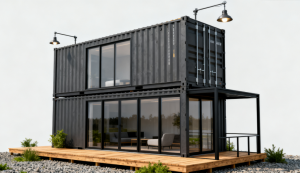1. Must-see for foreign trade practitioners: How can prefabricated houses crush the four major core pain points of the industry
Are you, who are engaged in foreign trade construction projects, troubled by these issues? Overseas site approvals are time-consuming, and the cost of cross-cean scheduling for construction teams is high; local material prices fluctuate greatly, with transportation losses exceeding 15%; project delay penalties cost tens of thousands of dollars per day; there significant differences in building regulations among countries, and the cost of compliance rectification is high… And prefabricated houses, with their “factory prefabrication -site assembly” model, turn these pain points into competitive advantages and become the first choice for foreign traders in more than 120 countries.
2. Core advantages prefabricated houses: Reconstruct the value of foreign trade construction in six dimensions
(1) Cost controllable: Reduce foreign trade construction expenditure by 30 from the source
The cost advantage of prefabricated houses stems from the integration of the entire industry chain. Factory standardization production makes the material loss rate ≤3%, far below the 15%-20% of traditional construction; core components use high-strength galvanized steel fireproof insulation board, with a purchase that is 25%-40% lower than local customization, and can also lock in prices to avoid fluctuation risks. Taking a 100㎡ foreign trade construction project an example, the traditional brick-concrete cost is $800-1000/㎡, while prefabricated houses only need $500-60/㎡, saving $20,000-35,000 per project. Moreover, prefabricated components are compact, and container transportation utilization by 40%, reducing cross-border logistics costs by 20%-30%.
(2) Ultra-fast delivery: Complete overseas project implementation in30 days, say goodbye to delay penalties
Prefabricated houses overturn the traditional construction period. The components are produced in domestic factories within 15-20 days and the foundation construction is carried out simultaneously at the overseas construction site; after cross-border transportation, a team of 6-8 people can assemble them in 7-0 days, with a total construction period of 30-45 days, which is more than 60% shorter than the traditional construction period. A certain African mining used it to start production two months in advance, avoiding a penalty of $120,000 and generating additional operating income of more than $500,00. Moreover, the components have a precision of millimeters, with zero errors and no need for secondary rectification.
3. Global compliance: Adapt to the standards of more than 120 countries, and easily pass local approvals
Our prefabricated houses have CE certification and are compatible with different climate and seismic intensity requirements. The tropical version uses moisture-proof and corrosion-proof technology ventilation modules, which can withstand typhoons of level 12 and fire rating B1; the-zone version is equipped with polyurethane insulation layer (thermal conductivity ≤ 0.024W/(m・K)) thermal bridge-free aluminum windows and, with a constant indoor temperature of 18-25℃; seismic zones use light steel structures, which can withstand an 8-level earthquake. We also provide a set of documents, including structural calculation books and inspection reports, to help with quick approvals.
4. Flexible adaptation: From temporary buildings to permanent residences, a variety of foreign trade scenarios
For temporary scenarios (construction site project departments, mining camps), you can choose mobile models that can be disassembled and reused, a relocation cost of only 10% of the traditional cost; for semi-permanent scenarios (cross-border e-commerce overseas warehouses), use modular assembly which can be quickly built from 100 to 5000㎡, with reserved expansion interfaces; for permanent scenarios (employee dormitories), choose reinforced concrete with a lifespan of more than 50 years and complete supporting facilities. You can also customize the appearance, such as brick or wood grain
(5) Energy Saving and Environmental Protection: Reduce 40% of operating costs, in line with the global green building trend
The utilization rate of prefabricated houses production exceeds 95%, which is 30% less than traditional construction waste; the use of air conditioning energy consumption is reduced by40%-50%, equipped with LED lights and water-saving appliances, which saves 1.5-30,000 US dollars per year in operating. Some models can be added with solar power supply and rainwater recycling system, suitable for remote projects, and meet LEED certification, which helps customers to obtain local support.
(6) Full Process Protection: From Design to After-sales, the Exclusive Service System for Foreign Trade Customers
Pre-sale: Provide customized design scheme (including threedimensional effect map, cost calculation table) according to the customer’s project location, scene and budget.
Mid-sale: Full tracking of logistics, and send technicians to the installation on-site.
After-sale: 2-year quality assurance, 12 service points set up in 5 continents around the world, 2-hour response, and also handle customs declaration and clearance.
3. Real Customer Cases: How Prefabricated Houses Assist Foreign Trade Projects in Cost Reduction and Efficiency Enhancement
Case 1: Southeast Asia Cross-border E-commerce Overseas Warehouse Project
The customer needed to build a 1500㎡ overseas warehouse Thailand with a delivery time of 3 months. The traditional construction period is 6 months with high costs. We used prefabricated houses with light steel structure, delivered in42 days, saving 35% in cost. The storage area has a load-bearing capacity of 500kg/㎡. The customer later added 2 orders
Case 2: African Gold Mine Camp Project
The customer needed to build a 200-person supporting facility for a gold mine in Ghana, requiring high and moisture resistance, and the ability to relocate. Traditional buildings are easily damaged and difficult to reuse. We customized mobile prefabricated houses, delivered in 38 days, an indoor temperature reduction of 8-10℃. After the project, the reuse of components saved $600,000.
Case 3: Temporary Office Housing Project
The customer needed to build an 800㎡ temporary office area in Germany that met EU standards. Traditional approval is difficult and carbon emissions are. We used CE-certified prefabricated houses, completed the approval and delivery in 25 days, and reduced carbon emissions by 50%. The customer a $12,000 subsidy and was recommended by 3 peers.
4.Why choose our prefabricated houses? 5 Core Competencies to Strengthen the Foundation of Cooperation
1.Rich in the foreign trade industry: Serving 5000 customers, covering 120 countries, understanding different market demands
2. Strong production capacity:3 major bases (120,000㎡), annual production capacity of 100,000㎡, advanced equipment with precision ≤0.mm
3. Professional R&D team: 20 engineers, 28 patents obtained, optimizing products for different regions
4. Perfect supply chain:ation with well-known building materials suppliers, self-owned logistics to optimize transportation
5. High cost-performance: Direct factory supply, 10%-15% price than peers, supporting payment methods such as FOB, CIF, DDP, etc.
5. Take Immediate Action: Seize the New Opportunities inabricated Houses Foreign Trade, Unlock Efficient Models for Construction Projects
The global foreign trade construction is undergoing a modular transformation, and prefabricated houses are to cost reduction and efficiency improvement. Consult now to enjoy three major benefits
1. Receive a custom design plan and cost calculation sheet for free
2. One–one policy and logistics issues answered by foreign trade consultants
Click here to get your exclusive plan!!!
Post time: Nov-03-2025






